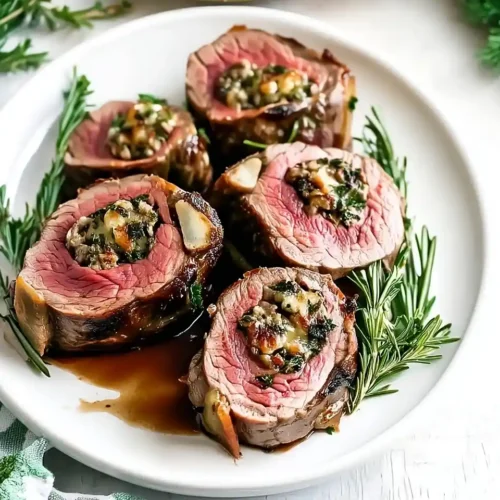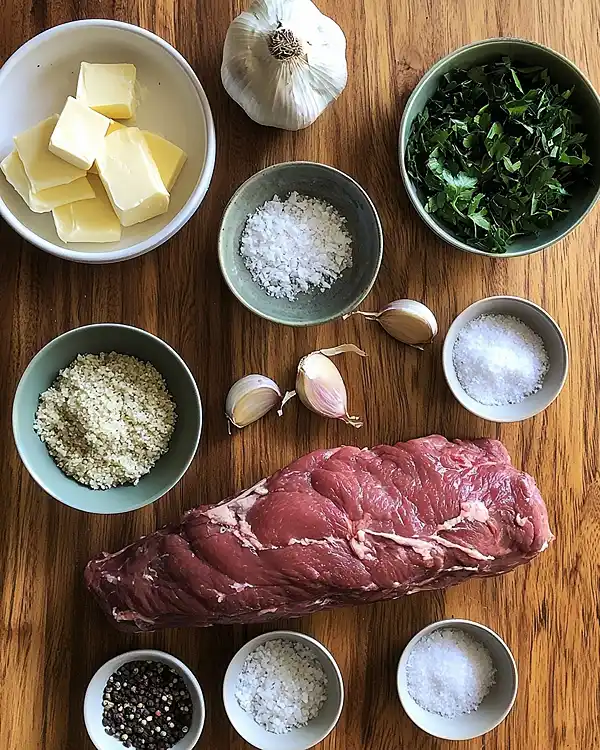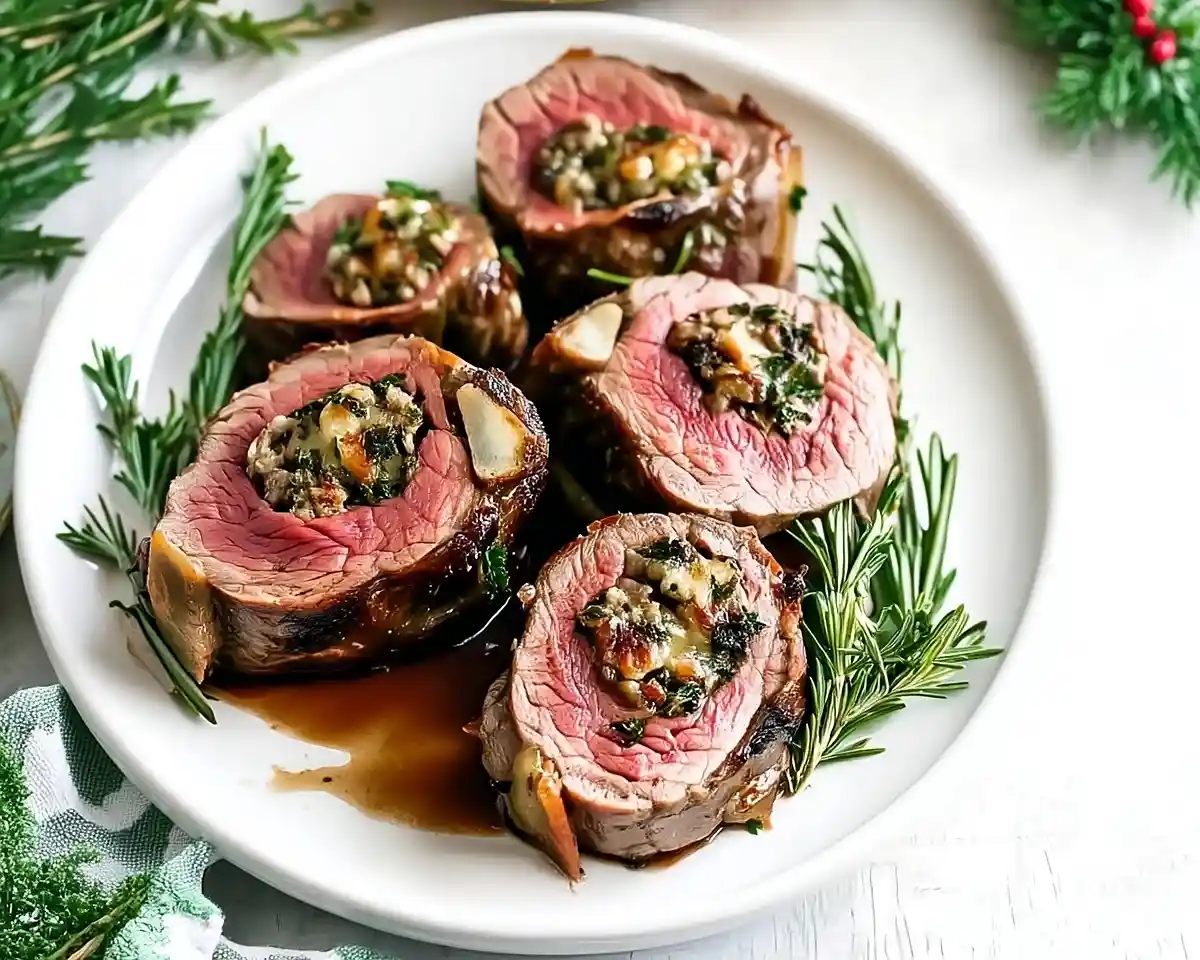Quick Christmas Stuffed Beef Tenderloin recipe with buttery herb stuffing. This main Christmas dish transforms your holiday table in under 90 minutes with expert tips.
Last December, I nearly panicked. My in-laws announced they were coming for Christmas dinner with just three days’ notice. I needed something impressive but manageable—something that screamed “I’ve got this” without the actual stress.
That’s when this Quick Christmas Stuffed Beef Tenderloin saved my holiday. The aroma of garlic and butter filled my kitchen while I actually enjoyed a glass of wine. My mother-in-law asked for the recipe twice before dessert arrived.
This stuffed beef roast delivers restaurant-quality results without the drama. You’ll slice into a gorgeous pinwheel of tender meat and golden stuffing that makes everyone reach for seconds. The buttery herb mixture stays perfectly moist while the beef develops a beautiful crust.
Tasty at Home – Where bold flavors meet everyday kitchens.
Table of Contents
Why This Main Christmas Dish Stands Out
This recipe transforms an elegant cut into an unforgettable centerpiece. The panko breadcrumb stuffing creates a light, aromatic filling that contrasts beautifully with the rich beef. Unlike dense traditional stuffings, this mixture stays fluffy and distributes evenly throughout each slice.
I’ve tested this stuffed beef tenderloin dozens of times. The pinwheel technique ensures every portion gets the perfect ratio of meat to stuffing. Your guests will marvel at the presentation, but you’ll know the secret—it’s actually straightforward to prepare.
The combination of fresh parsley, butter, and garlic creates layers of flavor. Each bite delivers savory richness balanced by bright herbal notes. This approach builds on classical French techniques while keeping things accessible for home cooks.

Quick Christmas Stuffed Beef Tenderloin
Equipment
- Chef’s knife
- Butcher’s twine
- Roasting pan with wire rack
- meat thermometer
- Mixing bowl
Ingredients
For the Stuffing
- 2 cups Panko breadcrumbs Creates lighter texture than regular breadcrumbs
- 1 cup Large onion, finely chopped Yellow or white onion works best
- 1 cup Unsalted butter, melted and cooled Must be cooled to avoid soggy breadcrumbs
- 2 tbsp Minced garlic Fresh only—jarred lacks aromatic punch
- 1½ cups Fresh parsley, finely chopped Italian flat-leaf preferred
For the Beef
- 1 roast (4–6 lb) Beef tenderloin Center cut, trimmed
- 2 tsp Kosher salt Diamond Crystal preferred; adjust if using table salt
- 2 tsp Freshly ground black pepper Pre-ground loses aromatic oils
Instructions
- Preheat the oven to 425°F (220°C). In a large bowl, combine panko breadcrumbs, onion, melted butter, garlic, and parsley. Mix until evenly coated and fluffy. Let rest while preparing the beef.
- Place the beef tenderloin on a cutting board. Starting about 1 inch from the top edge, slice horizontally to unroll the roast into a flat ½-inch thick sheet. Gently pound any uneven areas.
- Spread the stuffing evenly over the beef, leaving a 1-inch border. Roll tightly from the long side, securing with butcher’s twine every 2 inches. Season the outside with salt and pepper.
- Set the roast seam-side down on a wire rack inside a roasting pan. Roast for 50–70 minutes, checking for an internal temperature of 135°F for medium-rare or 150°F for medium. The crust should be deep brown and fragrant.
- Remove from oven and tent with foil. Rest for 10–15 minutes before slicing. Remove twine, slice ¾–1 inch thick, and serve warm to reveal the beautiful pinwheel stuffing.
Notes
Ingredient Quality Makes the Difference
For the stuffing base, fresh parsley is non-negotiable—dried herbs simply won’t deliver the same vibrant flavor. Quality unsalted butter allows you to control seasoning precisely while adding luxurious richness. Diamond Crystal Kosher Salt dissolves evenly and seasons without overwhelming.
Choose a center-cut beef tenderloin for consistent thickness. This ensures even cooking throughout the roast. Look for well-marbled meat with a deep red color and minimal silver skin already removed.
Complete Ingredient List

| Ingredient | US Measurement | Metric | Notes |
|---|---|---|---|
| For the Stuffing | |||
| Panko breadcrumbs | 2 cups | 120g | Creates lighter texture than regular breadcrumbs |
| Large onion (finely chopped) | 1 cup | 150g | Yellow or white onion works best |
| Unsalted butter (melted, cooled) | 1 cup | 227g | Must be cooled to avoid soggy breadcrumbs |
| Minced garlic | 2 tbsp | 18g | Fresh only—jarred lacks aromatic punch |
| Fresh parsley (finely chopped) | 1½ cups | 45g | Italian flat-leaf preferred |
| For the Beef | |||
| Beef tenderloin roast | 4-6 lb | 1.8-2.7kg | Center cut, trimmed |
| Diamond Crystal Kosher Salt | 2 tsp | 12g | Adjust if using table salt |
| Black pepper (freshly ground) | 2 tsp | 4g | Pre-ground loses aromatic oils |
Smart Shopping Tips for US Grocery Stores
Most American supermarkets carry beef tenderloin in the meat department, but you’ll find better prices at Costco or Sam’s Club. Order ahead during the holiday rush—December 20th through 24th sees limited availability. Ask your butcher to trim the silver skin and remove the chain muscle to save prep time.
Whole Foods and specialty markets offer grass-fed options if you prefer. However, conventional grain-finished beef provides the buttery texture most people expect in this elegant cut. Plan on 8 ounces per person for generous servings.
Ingredient Substitutions and Variations
Can’t find panko? Regular breadcrumbs work but add them gradually—they absorb butter more quickly. Start with 1½ cups and add more if the mixture seems too wet. Fresh herbs matter here, but in a pinch, use ½ cup dried parsley plus 2 tablespoons dried chives.
For a bolder stuffing, add 4 ounces crumbled blue cheese or goat cheese to the breadcrumb mixture. This creates tangy pockets throughout the roast. Mushroom lovers can sauté 8 ounces of finely chopped cremini mushrooms with the onions for earthy depth.
International readers using pork tenderloin can apply the same technique. Reduce cooking time by 10-15 minutes and target an internal temperature of 145°F. The stuffing ratio remains perfect for the smaller circumference.
Essential Equipment and Preparation
You’ll need a sharp chef’s knife or carving knife for the pinwheel cut. A dull blade tears the meat and creates uneven thickness. I learned this the hard way during my first attempt—ragged edges made rolling nearly impossible.
Butcher’s twine holds everything together during roasting. Cotton kitchen twine works perfectly and withstands high oven temperatures. Cut 5-6 pieces about 12 inches long before you start rolling. Having them ready prevents stuffing from spilling while you fumble with the spool.
A roasting pan with a wire rack elevates the meat for even heat circulation. This prevents the bottom from steaming and allows the entire surface to develop that gorgeous caramelized crust. A rimmed baking sheet works if you don’t have a dedicated roasting pan, but add the wire rack.
An instant-read meat thermometer eliminates guesswork. Digital models with thin probes give accurate readings without creating large holes that release precious juices. As Thomas Keller emphasizes in his teachings, precise temperature control separates adequate cooking from excellence.
Step 1: Create the Aromatic Stuffing
Preheat your oven to 425°F while you prepare the stuffing mixture. This high initial temperature creates the flavorful crust that seals in moisture. Meanwhile, combine panko breadcrumbs, minced garlic, finely chopped onion, melted butter, and fresh parsley in a large mixing bowl.
Stir gently until the breadcrumbs absorb the butter evenly. The mixture should hold together when squeezed but still feel light and fluffy. Let it rest while you prepare the beef—this allows the breadcrumbs to fully hydrate.
Step 2: Master the Pinwheel Butterfly Cut
Place your beef tenderloin on a clean cutting board with the thicker end facing your dominant hand. Position your knife parallel to the board, about 1 inch from the top edge. Well, this part intimidated me initially, but it’s actually quite forgiving once you understand the motion.
Start cutting horizontally while gently pulling the top section away from the knife. Think of unrolling a carpet—you’re gradually opening the meat rather than slicing through it. Work slowly in 1- to 2-inch increments, always keeping your blade parallel to the board.
Continue rolling and slicing until you’ve created one long, flat piece of meat. Aim for roughly ½-inch thickness throughout. Uneven spots are fine—just pound them gently with a meat mallet for consistency.
This technique comes straight from professional butchery practices. Julia Child demonstrated similar methods in her groundbreaking television series. The gradual unrolling prevents accidentally cutting through and creating separate pieces.
Step 3: Stuff and Secure Your Roast
Spread the breadcrumb mixture evenly across the flattened beef, leaving a 1-inch border on all sides. This border prevents stuffing from squeezing out during rolling. Press the mixture gently into the meat—you want good contact without compressing the light texture.
Starting from the long side closest to you, roll the beef tightly around the stuffing. Keep steady pressure as you roll to eliminate air pockets. Air gaps cause uneven cooking and can make slicing difficult.
Tie the rolled roast with butcher’s twine at 2-inch intervals. Start from the center and work toward the ends—this maintains even pressure throughout. Trim excess twine close to the knots. Season the exterior generously with salt and freshly ground black pepper, patting to help it adhere.
Step 4: Roast to Perfection
Place your stuffed beef roast on the wire rack in your roasting pan. Position it seam-side down initially—this helps the roll hold together as it cooks. Slide the pan onto the center oven rack for optimal heat circulation.
Roast for 50 to 70 minutes depending on your preferred doneness and the roast’s exact size. Start checking temperature after 45 minutes. Insert your thermometer into the thickest part of the meat, avoiding the stuffing layer which reads hotter.
Target 135°F for medium-rare or 150°F for medium. Remember that carryover cooking adds 5-10 degrees after you remove the roast from the oven. I once ignored this principle and ended up with medium-well beef instead of the medium-rare I wanted—learn from my mistake and pull it early.
The exterior should develop a rich brown crust while the stuffing turns golden at the edges. You’ll smell the garlic and butter intensifying as the roast approaches doneness. These sensory cues work alongside your thermometer readings.
Step 5: Rest Before Slicing
Transfer the finished roast to a cutting board and tent loosely with aluminum foil. Let it rest for 10 minutes minimum—15 is even better for larger roasts. This resting period allows muscle fibers to relax and reabsorb juices that migrated toward the surface during cooking.
Skipping this step results in a puddle of flavorful liquid on your cutting board instead of inside each slice. The internal temperature continues rising during this rest, completing the cooking process gently. Meanwhile, you can finish side dishes or make a quick pan sauce from the roasting drippings.
Remove the butcher’s twine carefully before slicing. Cut across the roll to reveal the beautiful pinwheel pattern. Aim for ¾-inch to 1-inch thick slices—thinner pieces fall apart while thicker ones become difficult to eat. Arrange on a warm platter and prepare for compliments.

Expert Tips for Guaranteed Success
Always bring your beef to room temperature before stuffing. Remove it from the refrigerator 45 minutes before you start preparing the recipe. Cold meat contracts more during cooking, potentially squeezing out stuffing. This simple step ensures even cooking from edge to center.
Don’t overstuff the roast. Too much filling creates excessive pressure when you roll and tie the meat. Excess stuffing squeezes out during cooking, burning on the pan and creating smoke. Aim for a layer about ½ inch thick across the flattened beef.
Consider dry-brining the tenderloin overnight. Salt the exterior 12-24 hours before cooking, then refrigerate uncovered. This technique seasons deeply while drying the surface for better browning. It’s a professional restaurant trick that dramatically improves flavor and texture.
Creative Variations for Different Occasions
Italian-Inspired Stuffing: Replace parsley with fresh basil and add ½ cup sun-dried tomatoes plus ¼ cup pine nuts. The Mediterranean flavors work beautifully with beef’s richness. Mix in 2 tablespoons of tomato paste for deeper color and umami punch.
Southern Twist: Substitute cornbread crumbs for panko and add 4 strips of crispy crumbled bacon to the mixture. Include 2 tablespoons of Dijon mustard brushed on the meat before stuffing. This creates a barbecue-adjacent flavor profile perfect for non-traditional holiday celebrations.
Mushroom Duxelles Version: Sauté 1 pound of finely chopped mushrooms with shallots until all liquid evaporates. Mix with breadcrumbs, fresh thyme, and a splash of cognac. This classic French preparation elevates the dish to fine-dining status while adding earthy complexity.
Holiday Cranberry Addition: Fold ½ cup of dried cranberries and chopped pecans into your standard stuffing mixture. The tart sweetness complements the savory beef while adding festive color. This pairs exceptionally well with cranberry sauce on the side.
Cheese Lover’s Dream: Layer thin slices of Gruyère or fontina cheese over the stuffing before rolling. The melted cheese creates luxurious pockets throughout each slice. Add fresh sage leaves for an aromatic boost that cuts through the richness.
Storage and Make-Ahead Strategy
You can prepare the stuffing mixture up to 2 days ahead. Store it covered in the refrigerator and bring to room temperature before using. The flavors actually improve as the ingredients meld together. Don’t butterfly or stuff the meat until the day you plan to cook—raw meat deteriorates quickly once its surface area increases.
Leftover stuffed beef tenderloin keeps for 3-4 days refrigerated in an airtight container. Slice only what you need and store the remaining roast whole—this preserves moisture better than pre-sliced portions. Reheat gently in a 300°F oven until just warmed through, about 15 minutes.
For longer storage, freeze the cooked roast whole or sliced. Wrap tightly in plastic wrap, then aluminum foil to prevent freezer burn. Properly wrapped beef maintains quality for 2-3 months. Thaw overnight in the refrigerator before reheating.
| Storage Method | Duration | Best Practice |
|---|---|---|
| Room Temperature | 2 hours max | Keep covered, away from heat |
| Refrigerator (cooked) | 3-4 days | Airtight container, whole if possible |
| Freezer (cooked) | 2-3 months | Double-wrapped, labeled with date |
| Stuffing (prepared) | 2 days | Covered in refrigerator |
Perfect Holiday Pairings
This stuffed beef roast pairs beautifully with classic roasted vegetables and festive side dishes. Consider creamy mashed potatoes or a rich potato gratin to complement the lean beef. Roasted Brussels sprouts with bacon add a crispy, savory contrast to the tender meat.
A full-bodied red wine enhances the dining experience. Look for California Cabernet Sauvignon or Washington State Merlot—both have enough structure to stand up to the rich flavors without overwhelming them. These American wines showcase regional terroir while supporting domestic producers.
For a complete Christmas spread, serve alongside traditional cranberry sauce and buttery dinner rolls. The tart cranberries cut through the richness while the rolls soak up any pan juices beautifully. Add a simple arugula salad with lemon vinaigrette to refresh palates between bites.
Christmas Stuffed Beef Tenderloin FAQs
Can you prepare stuffed beef tenderloin ahead of time?
You can prepare stuffed beef tenderloin by making the stuffing mixture up to 2 days in advance and storing it refrigerated. However, butterfly and stuff the actual beef roast on the day you plan to cook it—raw butterflied meat loses moisture quickly. You can stuff and tie it up to 4 hours before roasting, keeping it refrigerated until ready to cook.
What’s the best way to reheat leftover stuffed beef roast?
The best way to reheat leftover stuffed beef roast is in a 300°F oven wrapped loosely in foil. This gentle method warms the meat through without overcooking the exterior. Plan on 15-20 minutes for refrigerated slices or 25-30 minutes for a whole section. Avoid microwaving, which creates tough, rubbery texture.
How do you know when stuffed beef tenderloin is done?
You know when stuffed beef tenderloin is done by checking the internal temperature with an instant-read thermometer. Insert it into the thickest part of the meat, avoiding the stuffing layer. Target 135°F for medium-rare or 150°F for medium, then remove from the oven. The temperature will rise another 5-10 degrees during resting.
Can you use different meats for this stuffing technique?
You can use different meats for this stuffing technique, including pork tenderloin, boneless leg of lamb, or even large chicken breasts. Adjust cooking times based on the protein—pork and chicken need 145°F and 165°F respectively. The pinwheel cutting technique works identically across different proteins with similar cylindrical shapes.
Bring This Showstopper to Your Table

This Quick Christmas Stuffed Beef Tenderloin transforms your holiday gathering into a memorable feast. The impressive presentation belies the straightforward preparation—your secret weapon for stress-free entertaining. Each perfectly portioned slice reveals that gorgeous spiral of herb-studded stuffing that makes this main Christmas dish truly special.
You know what pairs perfectly with this roast? A warm, comforting dessert like homemade apple pie or rich caramel apple cheesecake bars. The sweet conclusion balances the savory main course beautifully.
Ready to become your family’s holiday hero? Grab that tenderloin and get rolling. Share your pinwheel masterpiece in the comments below—I love seeing how this recipe comes to life in your kitchen.
Pro tip: Snap a photo before everyone dives in. This dish photographs beautifully, and you’ll want evidence of your culinary triumph before it disappears!

